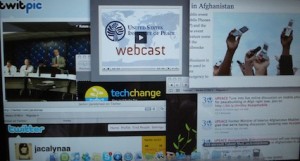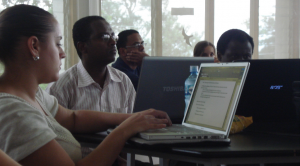Several of us at TechChange had the privilege of attending a great event MobileActive and the World Bank put on last night that focused on those failures that I’m sure most involved try to forget. FAILFaireDC brought together some real pioneers in the ICT4D space to discuss issues they had dealt with and well-intentioned projects that went wrong. While the fails ranged from election monitoring and e-governance to ICT for education and health, some key concepts kept popping up. Most importantly? Hubris kills.
Category: Blog
A technique recently used by Russian spies to communicate with their handlers could be used by dissidents to spread information from within totalitarian regimes. Unlike cryptography which encodes a message with a cypher, steganography hides content in plain sight.
An issue that comes up time and again in the technology for development space is whether to focus on an applications’ reach or the richness of services provided. In the next couple of posts I’m going to be looking at how this debate is playing out in mHealth.
With the help of Leonardo DiCaprio, we know what blood diamonds are. And now, thanks to the Enough Project, we are starting to know more about conflict minerals. Conflict minerals are generally defined as: “minerals mined in conditions of armed conflict and human rights abuses, notably in the eastern provinces of the Democratic Republic of the Congo, by the Congolese National Army and various armed rebel groups, including the Democratic Forces for the Liberation of Rwanda”.
Three days later as if to highlight the challenges that still remain the Seacom fiber optic cable connecting east Africa to India and Europe failed. The disruption brought connection speeds in Tanzania and Kenya to a crawl while Uganda and Rwanda switched back to more expensive satellite connections. Submarine cables are difficult to repair and vulnerable to accident or malfeasance. In 2008 large parts of the Middle East and Asia were left without connections after an anchor severed the FLAG cable in the Mediterranean.
The challenges don’t end once a cable is laid; extending the connection to rural locations is difficult and costly. Copper wire used for low bandwidth lines is frequently stolen with South Africa alone estimated to lose $1 billion dollars because of replacement costs. These examples highlight both the potential and vulnerability of an increasingly sophisticated communications infrastructure.
On July 2nd, the Main One Cable company finished construction on a 4000 mile fiber optic cable linking Nigeria to Western Europe. The new pipe promises 20 times the capacity of sub-Saharan Africa’s entire satellite network. The Main One is one of 10 new cables being laid to Africa which promise to drive down costs and expand access.
Anyone can submit work for this project. All you need is a camera and access to an email account. Refer to the following guidelines for submissions:
Submission Guidelines
Images must be taken in public spaces with consent where possible. Images of children and those of illegal or compromising behavior will not be accepted.
Submissions need to include the following:
Name of the photographer
Location of the image(s)
Time/Date of the image(s)
Brief description
Submit through:
Facebook: www.facebook.com/techchange
Email: Images may be sent to keith@techchange.org
Submission deadline: August 15, 2010.
Any banking services. While those in the developed world take it for granted, easy access to a bank is a luxury unknown to most. Throw in a devastating earthquake that knocks out a third of the banks and ATMs in the country and you can see why Bill Gates is banking on mobile phones to help expand financial access in Haiti. His foundation recently set up a $10 million fund to provide grants to the first firm to implement a qualifying mobile banking system as well as the first to process five million transactions.
 Yesterday’s Can You Help Me Now? Mobile Phones and Peacebuilding In Afghanistan panel at the United States Institute for Peace (USIP) showcased experts on Afghanistan from all walks of life—government officials, programmers, and even social media gurus.
Yesterday’s Can You Help Me Now? Mobile Phones and Peacebuilding In Afghanistan panel at the United States Institute for Peace (USIP) showcased experts on Afghanistan from all walks of life—government officials, programmers, and even social media gurus.
This event drew in a crowd of enthusiastic Twitterers using the hashtag #usipmobile, sharing questions and comments throughout the event and highlighting some of the key quotes of the day. Corresponding with the panel discussion, Twitter users tweeted about everything from improving governance (i.e. rule of law and anti-corruption) to countering extremism (i.e. media development and counter-insurgency) to delivery of essential services (i.e. education, health, agricultural development, and commerce).
 Last week, TechChange Co-Founder and President Nick Martin taught a one-week course on Technology and Peace at the United Nations-mandated University for Peace (UPEACE). It was the first course of its kind taught at the university. Participants engaged in a variety of discussions, case studies, and practical exercises involving how technology can be used for building peace. The course also made use of a number of new technology-focused teaching techniques to ease the learning process.
Last week, TechChange Co-Founder and President Nick Martin taught a one-week course on Technology and Peace at the United Nations-mandated University for Peace (UPEACE). It was the first course of its kind taught at the university. Participants engaged in a variety of discussions, case studies, and practical exercises involving how technology can be used for building peace. The course also made use of a number of new technology-focused teaching techniques to ease the learning process.
